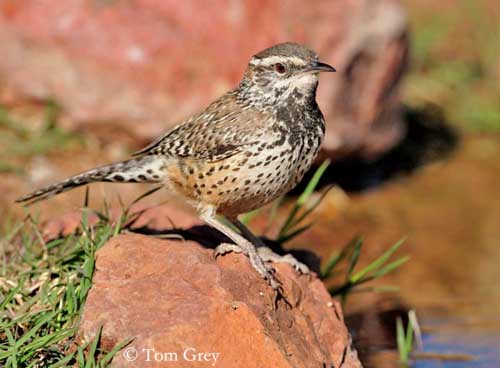
Fr: Troglodyte des cactus
All : Kaktuszaunkönig
Esp : Ratona Desértica
Ital: Scricciolo dei cactus
Nd: Cactuswinterkoning
Sd: Kaktusgärdsmyg
Photographers:
Tom Grey
Tom Grey's Bird Pictures
Tom Merigan
Tom Merigan’s Photo Galleries
Pete Moulton
Pete Moulton Photography
Text by Nicole Bouglouan
Sources:
HANDBOOK OF THE BIRDS OF THE WORLD Vol 10 by Josep del Hoyo-Andrew Elliott-David Christie - Lynx Edicions - ISBN: 8487334725
A GUIDE TO THE BIRDS OF MEXICO AND NORTHERN CENTRAL AMERICA by Steve N. G. Howell, Sophie Webb - Oxford University Press - ISBN: 0198540124
WRENS, DIPPERS AND THRASHERS by Brewer David – illustrated by Barry Kent Mackay- Yale University Press - ISBN: 0300090595
FIELD GUIDE TO THE BIRDS OF NORTH AMERICA - National Geographic Society - ISBN: 0792274512
BirdLife International (BirdLife International)
Exploring the Southwest Desert USA
Cactus Wren
Campylorhynchus brunneicapillus
Passeriforme Order – Troglodytidae Family
BIOMETRICS:
Length: 18-19 cm
Weight: 33-47 g
DESCRIPTION:
The Cactus Wren is a bird of the arid areas of the state of Arizona, of which this species is the national bird since 1931. It is the largest wren of North America.
The adult male has grey-brown upperparts streaked black and white. On the upperwing, primary and secondary flight feathers are strongly barred blackish and creamy- white. On the uppertail, the rectrices are barred dark brown and pale grey-brown, and the outer ones are white-tipped.

On the underparts, the chin is white. The whitish throat and the upper breast are heavily mottled black. The belly is whitish with brownish streaks. Flanks and vent are pale rufous. Undertail-coverts are whitish spotted dark brown.
On the head, the crown is chocolate-brown. We can see a conspicuous white supercilium. Ear-coverts are streaked brownish-grey and white. The brown nape is streaked white.
The slightly down-curved bill is blackish with pale grey base of lower mandible. The eyes are reddish-brown. The long legs and the feet are pale pinkish-brown.
Both sexes are similar.
The juvenile lacks the white streaks on nape and back. The upper breast is less marked black. The eyes are grey-brown.
We can find several subspecies which differ in colour and pattern, with more or less streaks or spots.
VOICE: SOUNDS BY XENO-CANTO
The Cactus Wren’s song is heard all year round. It is a low-pitched, harsh, rapid and rhythmic “jar-jar-jar-jar” becoming louder at the end.
The alarm call is a low buzz, and also a repeated “tek-tek-tek-tek”.
During the territorial encounters, the birds give harsh, scratchy calls.
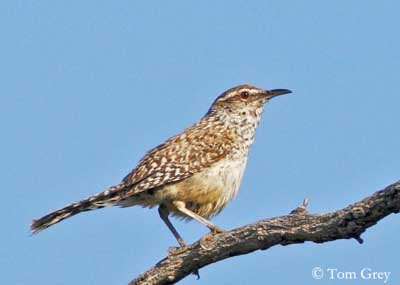
HABITAT:
The Cactus Wren frequents desert and semi-desert with various plant species, and mainly spiny cacti for nesting. It is usually found in the areas where cacti mesquite and yucca are present. It can be seen from sea-level up to 1400 metres in Arizona, and up to 2000 metres of elevation in New Mexico and Central Mexican plateau.
RANGE:
The Cactus Wren occurs in Arizona, S California, S Nevada, W Texas, SW Utah and NC Mexico.
BEHAVIOUR:
The Cactus Wren feeds mainly on various insects, spiders, small frogs and lizards, and also seeds and fruits from cacti. It forages in the low vegetation and on the ground, turning over rocks and stones or other items in order to find hidden preys. As all wren species, it moves rapidly and uses its long curved bill to catch the preys from various places, including bark crevices.
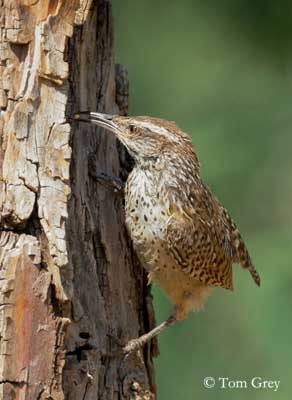
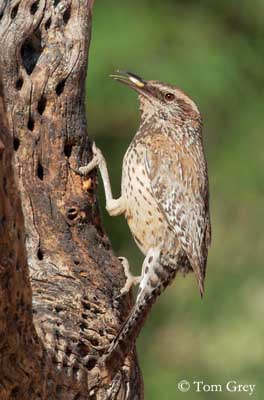
The Cactus Wren is monogamous and both mates stay together for long time. They produce several clutches, up to six, but only two or three succeed. The territory is strongly defended all the year because this bird is sedentary and remains in its range.
At the beginning of the breeding season, they utter complex songs and duets. The female selects the nest-site and both adults build the nest.
The Cactus Wren is always very active, and often investigates anything new within its territory. It moves rapidly with frequently quivered tail, but not cocked up like the Eurasian Wren does.
They roost in nests built only for roosting throughout the year.
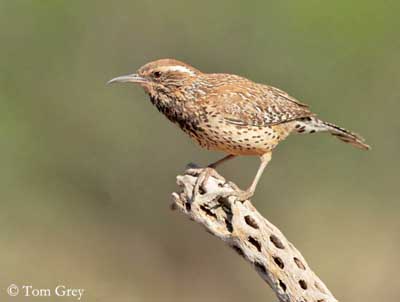
FLIGHT:
The Cactus Wren performs short, direct flight, usually fairly low.
REPRODUCTION:
The egg laying starts in February in Arizona, but later at higher elevations.
The nest is a bulky, domed, pouch-shaped structure, with a tube-like side entrance of about 15 centimetres long. Such nest is made with grass, plant fibres, twigs and dried leaves, and the interior is lined with feathers or fur, and sometimes artificial materials when available.
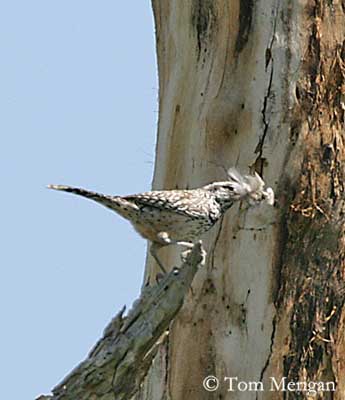
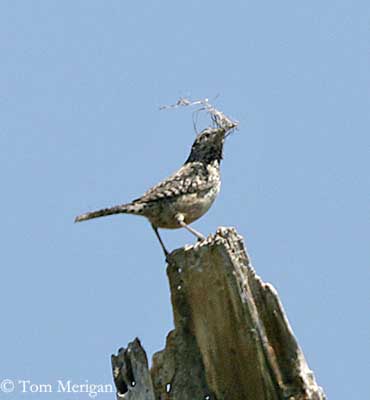
This structure is often placed in a large spiny cactus or a thick shrub. Other nests are built for roosting throughout the year.
The female lays 3-5 buffy-pinkish eggs with brown markings. She incubates alone during about 16 days. The chicks are fed by both parents. They fledge 19-23 days after hatching, but they depend on parents for food for one month more.
As soon as the first chicks are fledged, the female lays a second clutch in another nest built by the male while the female was laying the first brood.
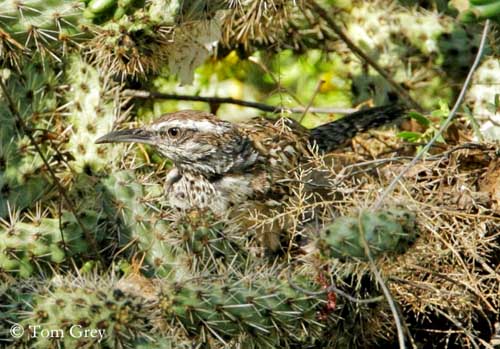
The nest-site is situated in thorny cacti and plants to give a good protection against the predators. However, snakes such as Coach Whip (Masticophis flagellum) take the eggs and the nestling in Arizona.
DIET:
The Cactus Wren feeds primarily on numerous insects such as ants, beetles, grasshoppers and wasps. It also takes spiders, small frogs and lizards. Some plant matter such as cactus seeds and fruits can be added.
It forages on the ground and in low vegetation, turning over debris, stones and rocks to reach the invertebrates hidden beneath.
PROTECTION / THREATS / STATUS:
The Cactus Wren is common or abundant in most parts of the range. This species is able to adapt to modified or degraded habitats so long as spiny cacti remain.
This species is not currently threatened.
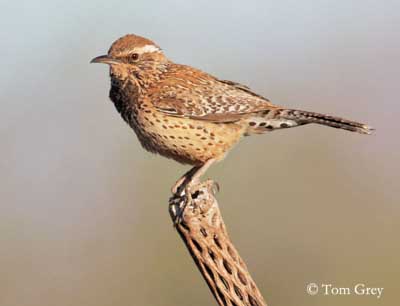
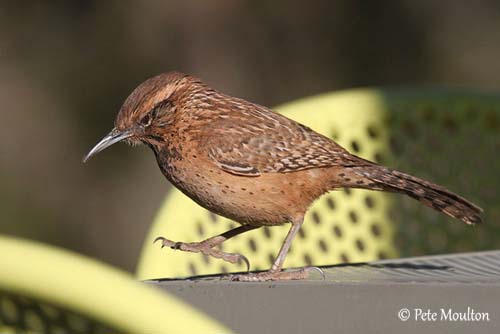
The birds above show unusual tawny coloration. This is a known, but rare, form of melanism.
Tom Grey's bird is slightly paler than that of Pete Moulton, but both are dark forms.